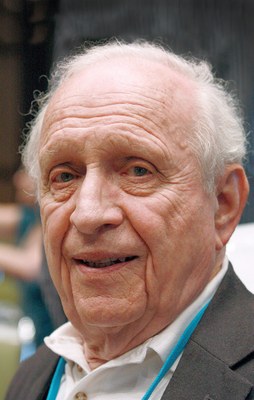Roy Glauber
1925 – 2018
Class of 2013-14

Harvard University
Nobel Prize in Physics
National Academy of Sciences
In 1963, U.S. theoretical physicist Roy J. Glauber published his historic paper, “The Quantum Theory of Optical Coherence,” which explained the fundamental characteristics of different types of light—from lasers to light bulbs. Glauber’s theory of photodetection is highly influential in quantum optics and led to his sharing the 2005 Nobel Prize in physics “for his contributions to the quantum theory of optical coherence.”
From the beginning of his career, Glauber has worked at the vanguard of modern physics. At age eighteen as a junior at Harvard University during World War II, Glauber joined the Manhattan Project at Los Alamos, N.M., where he helped to calculate the critical mass for the first atom bombs.
He returned to Harvard after the war, and earned his doctorate in 1949. His mentors include another Nobel laureate, theoretical physicist Julian Schwinger, and the scientific leader of the Manhattan Project, theoretical physicist J. Robert Oppenheimer.
Today, as Harvard’s Mallinckrodt Professor of Physics, Glauber focuses his research on solving problems in quantum optics, a field that studies the interactions between light and matter. He continues to work in high-energy collision theory and to study the statistical correlation of particles produced in high-energy reactions.
Specific topics of his current research include: the quantum mechanical behavior of trapped wave packets; interactions of light with trapped ions; atom counting, which deals with the statistical properties of free atom beams and their measurement; algebraic methods for dealing with fermion statistics; coherence and correlations of bosonic atoms near the Bose–Einstein condensation; the theory of continuously monitored photon counting and its reaction on quantum sources; the fundamental nature of “quantum jumps,” which are abrupt transitions of an electron, atom, or molecule from one quantum state to another; the resonant transport of multiple particles produced in high-energy collisions; and the multiple diffraction model of proton-proton and proton-antiproton scattering.
Glauber received the Albert A. Michelson Medal from the Franklin Institute in Philadelphia in 1985; the Max Born Award from the Optical Society of America, also in 1985; the Dannie Heineman Prize for Mathematical Physics from the American Physical Society in 1996; and the Gold Medal from Spain’s National Research Council in 2008.
His most important works from 1963 to 1999 are collected in Quantum Theory of Optical Coherence. Selected Papers and Lectures, published in 2007.
While serving as a TIAS Faculty Fellow, Glauber collaborated with Marlan O. Scully, distinguished professor, and Anatoly Svidzinsky, visiting assistant professor of applied physics, both of the Institute of Quantum Science and Engineering, College of Science; Wolfgang P. Schleich, professor of theoretical physics, Ulm University, 2013-14 TIAS Faculty Fellow; and other faculty and researchers in the College of Science’s Department of Physics and Astronomy.
For more updated information:
Students
Timur Akhmedzhanov – 2013-14
